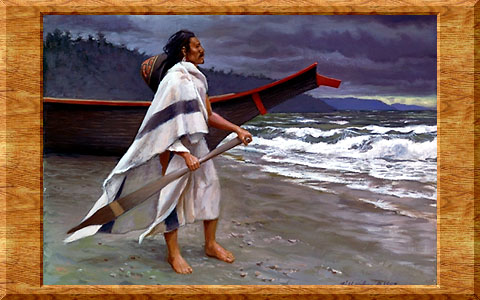
Original oil 14" x 18" by Bill Holm © 1993
Collection of Bruce and Linda Colasurdo
Although the Native peoples of the Northwest Coast, and especially those tribes living along the outer shores of Vancouver Island and the Olympic Peninsula, were expert in the use of the canoes in the open sea, there were often times when it was prudent just to wait for better weather. An impatient Nuu-chah-nulth paddler, the captain of the large travelling canoe beside him, looks intently out to sea, waiting for the sign that the storm will let up, and he can assemble his crew and be off. Without his responsibility, they are resting in the shelter of the tangled driftwood at the top of the beach. Far to the south a glimmer of sunlight suggests that the time to pull the big canoe into the diminishing surf may come before long.
The long yew-wood paddle with constricted grip and broad blade with an extended, tapering point, is characteristic of the paddles used by the West Coast tribes. The black colour was produced by smoking the oiled paddle, the blade bound with a protective strip of kelp leaf, over a pitch fire, leaving a decorative band of unsmoked wood crossing the blade. The hat slung on the paddler's back by its chin ties is a distinctive Nuu-chah-nulth style, woven of split spruce root and painted with a black rim and stylized zoomorphic detail in black and red on the crown. His ear pendants are of dentalium shells, fished by these West Coast people and traded widely to tribes who lacked a source of the prized shell. A white Hudson's Bay Company blanket, pinned over his shoulder, completes his dress. It was the usual overgarment on the coast in the mid-nineteenth century, replacing the more traditional cedar-bark capes and robes as common clothing for Nuu-chah-nulth males.